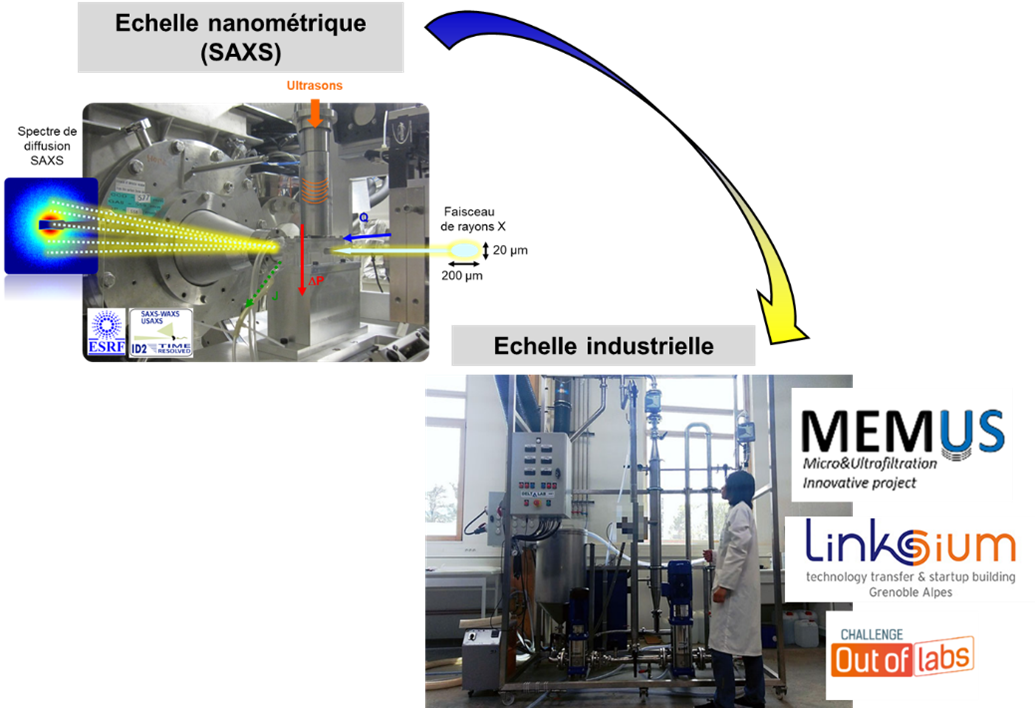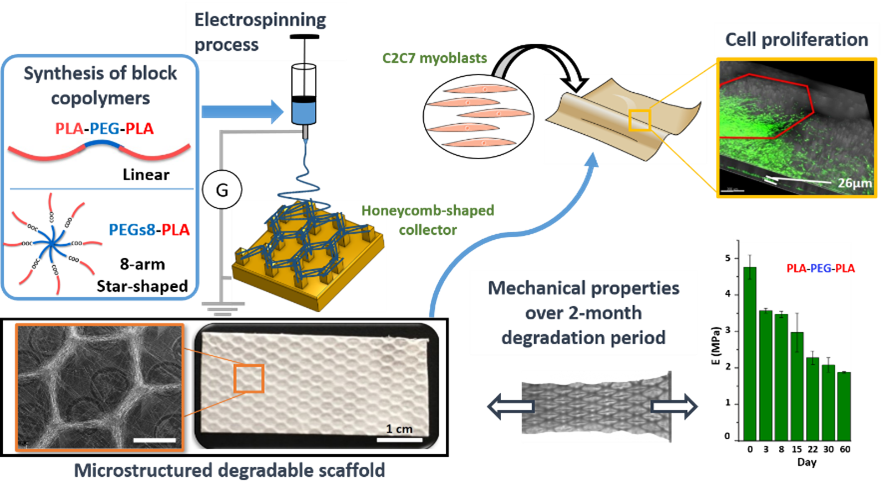- Share
- Share on Facebook
- Share on X
- Share on LinkedIn

Low-frequency ultrasound (20 kHz) is used in micro- and ultrafiltration processes to control membrane fouling and enhance filtration performance.
Objectives
The objective of this project is to address the limitations of conventional micro- and ultrafiltration processes. Low-frequency ultrasound generates physical effects within a liquid that interact with the concentrated layers at the membrane surface. Various colloidal suspensions have been filtered in the presence of ultrasound, and performance evaluations revealed different impacts depending on the system, consistently showing an increase in permeate flux. A scale-up project was undertaken to develop a new semi-industrial module operating under ultrasound, equipped with seven industrial ceramic membranes, each 1.2 m long and 25 mm in diameter, based on a filed patent.
Results
Multiscale Approach to Fouling under Ultrasound
We have conducted studies ranging from the laboratory-scale filtration cell—measuring filtration performance and retention rates—to the nanometer/micrometer scale of particles accumulated on the membrane surface, with and without ultrasound. In situ characterizations using small-angle X-ray scattering (SAXS) and particle image velocimetry (PIV) enabled us to understand the effect of ultrasound on the particle layers at the membrane surface and on overall process performance. Various colloidal suspensions were filtered, including clays (Laponite, Wyoming), macromolecules (casein micelles), natural nanoparticles (cellulose nanocrystals, starch nanocrystals), and fruit juice suspensions. SAXS measurements revealed the solute concentration profiles at the membrane surface under different experimental conditions, in situ and in real time during filtration.

These concentrated layers were subjected to low-frequency ultrasound (20 kHz) to reduce fouling. It was shown that the rheological properties of the suspensions controlled the effect of ultrasound on the accumulated layers, leading either to the complete removal of the layer or to a slight reduction. The understanding and control of these effects at the laboratory scale enabled the transfer of these process improvements to an industrial scale through the development of an operational ultrasound-assisted membrane module using commercial ceramic membranes.
Scale-up
MEMUS aims to address a major challenge in all industrial filtration processes: membrane fouling and the resulting decrease in filtration performance. This project was funded by SATT Linksium. Today, industry has no choice but to perform regular membrane cleaning, often by backwashing, which causes downtime, significant costs, and a notable environmental impact.
The MEMUS process couples ceramic membrane filtration with the use of ultrasound, which not only improves permeate flux by 20–30% during operation but also prevents pore fouling through vibrations transmitted to the filtration module.

This process, developed at the laboratory scale, is now being scaled up to a pilot level to demonstrate its industrial relevance in the wastewater treatment, agri-food, and chemical sectors. Proof-of-concept studies with industrial partners and membrane technology integrators, both in France and abroad, are underway with the aim of identifying potential licensees for this innovation.
References
-
Jin Yao, Hengl Nicolas, Baup Stéphane, Pignon Frédéric, Gondrexon Nicolas, Sztucki Michael, Romdhane Ahlem., Guillet Agnés, Aurousseau Marc, "Ultrasonic assisted cross-flow ultrafiltration of starch and cellulose nanocrystals suspensions: Characterization at multi-scales", Carbohydrate Polymers, 124, 66-76 (2015). https://doi.org/10.1016/j.carbpol.2015.01.073
-
Semeraro Enrico F., Hengl Nicolas, Karrouch Mohamed, Michot Laurent J., Paineau Erwan, Jean Bruno, Putaux Jean-Luc, Lancelon-Pin Christine, Sharpnack Lewis, Pignon Frédéric, "Layered organization of anisometric cellulose nanocrystals and beidellite clay particles accumulated near the membrane surface during cross-flow ultrafiltration: In situ SAXS and ex situ SEM/WAXD characterization", Colloids and Surfaces A: Physicochemical and Engineering Aspects, 584, 124030 (2020). http://doi.org/10.1016/j.colsurfa.2019.124030
-
Brevet d’invention : Notice n° WO2021105609 ’’Dispositif De Filtration De Liquide Comprenant Un Module D'émission D'ultrasons’’, Nicolas Hengl, Frédéric Pignon, Nicolas Gondrexon, Stephane Baup, Yao Jin https://data.inpi.fr/brevets/WO2021105609?q=Hengl%20Nicolas#WO2021105609jnknklnn
Team members involved
- Share
- Share on Facebook
- Share on X
- Share on LinkedIn